Impact of Global Financial Crisis on Corporate Accounting Practices
VerifiedAdded on 2020/05/28
|13
|2714
|79
Report
AI Summary
This report provides a comprehensive analysis of the 2008-2009 global financial crisis (GFC), examining its causes, including global savings imbalances, housing price declines, increased interest rates, and credit booms. It explores the impact on various economies, with a specific focus on Nepal, detailing the effects on the financial sector, remittance flows, foreign exchange reserves, macroeconomic balances, and the housing and share markets. The report also discusses potential for the crisis to repeat and analyzes reforms such as capital planning, stress testing, and high capital regulations. It concludes by summarizing the crisis's wide-ranging effects and highlighting the importance of understanding its implications for corporate financial accounting and economic stability. The report is contributed by a student to be published on the website Desklib, a platform which provides all the necessary AI based study tools for students.
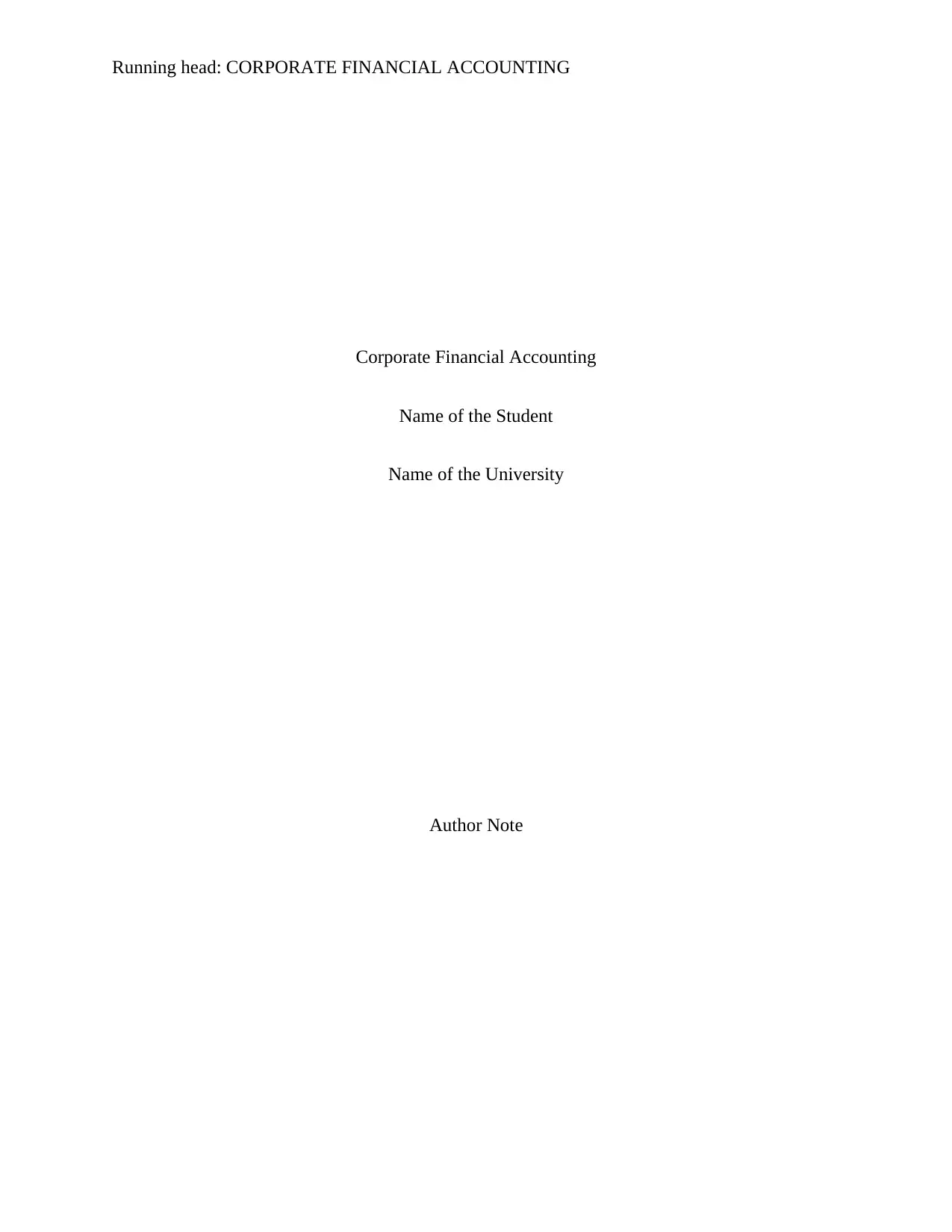
Running head: CORPORATE FINANCIAL ACCOUNTING
Corporate Financial Accounting
Name of the Student
Name of the University
Author Note
Corporate Financial Accounting
Name of the Student
Name of the University
Author Note
Paraphrase This Document
Need a fresh take? Get an instant paraphrase of this document with our AI Paraphraser
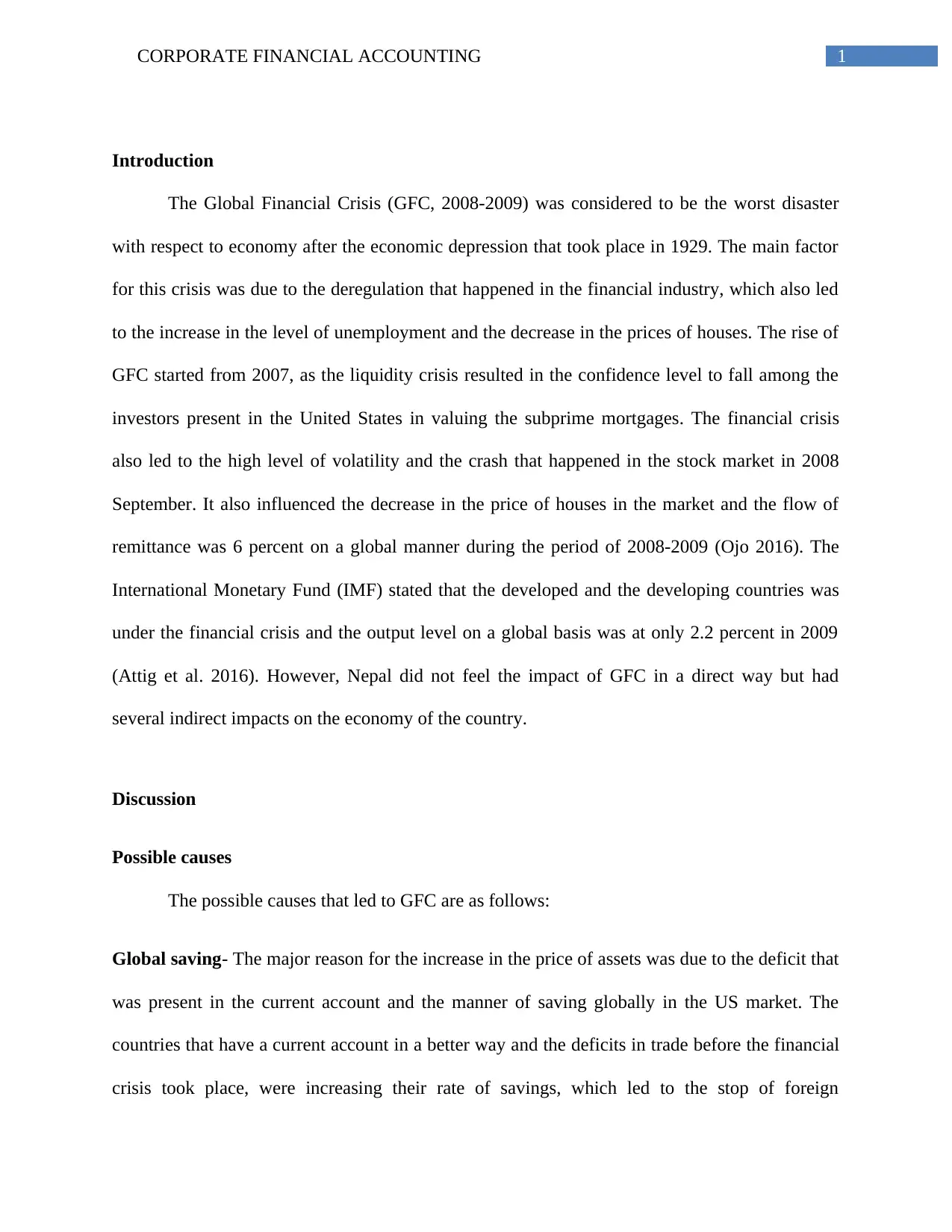
1CORPORATE FINANCIAL ACCOUNTING
Introduction
The Global Financial Crisis (GFC, 2008-2009) was considered to be the worst disaster
with respect to economy after the economic depression that took place in 1929. The main factor
for this crisis was due to the deregulation that happened in the financial industry, which also led
to the increase in the level of unemployment and the decrease in the prices of houses. The rise of
GFC started from 2007, as the liquidity crisis resulted in the confidence level to fall among the
investors present in the United States in valuing the subprime mortgages. The financial crisis
also led to the high level of volatility and the crash that happened in the stock market in 2008
September. It also influenced the decrease in the price of houses in the market and the flow of
remittance was 6 percent on a global manner during the period of 2008-2009 (Ojo 2016). The
International Monetary Fund (IMF) stated that the developed and the developing countries was
under the financial crisis and the output level on a global basis was at only 2.2 percent in 2009
(Attig et al. 2016). However, Nepal did not feel the impact of GFC in a direct way but had
several indirect impacts on the economy of the country.
Discussion
Possible causes
The possible causes that led to GFC are as follows:
Global saving- The major reason for the increase in the price of assets was due to the deficit that
was present in the current account and the manner of saving globally in the US market. The
countries that have a current account in a better way and the deficits in trade before the financial
crisis took place, were increasing their rate of savings, which led to the stop of foreign
Introduction
The Global Financial Crisis (GFC, 2008-2009) was considered to be the worst disaster
with respect to economy after the economic depression that took place in 1929. The main factor
for this crisis was due to the deregulation that happened in the financial industry, which also led
to the increase in the level of unemployment and the decrease in the prices of houses. The rise of
GFC started from 2007, as the liquidity crisis resulted in the confidence level to fall among the
investors present in the United States in valuing the subprime mortgages. The financial crisis
also led to the high level of volatility and the crash that happened in the stock market in 2008
September. It also influenced the decrease in the price of houses in the market and the flow of
remittance was 6 percent on a global manner during the period of 2008-2009 (Ojo 2016). The
International Monetary Fund (IMF) stated that the developed and the developing countries was
under the financial crisis and the output level on a global basis was at only 2.2 percent in 2009
(Attig et al. 2016). However, Nepal did not feel the impact of GFC in a direct way but had
several indirect impacts on the economy of the country.
Discussion
Possible causes
The possible causes that led to GFC are as follows:
Global saving- The major reason for the increase in the price of assets was due to the deficit that
was present in the current account and the manner of saving globally in the US market. The
countries that have a current account in a better way and the deficits in trade before the financial
crisis took place, were increasing their rate of savings, which led to the stop of foreign
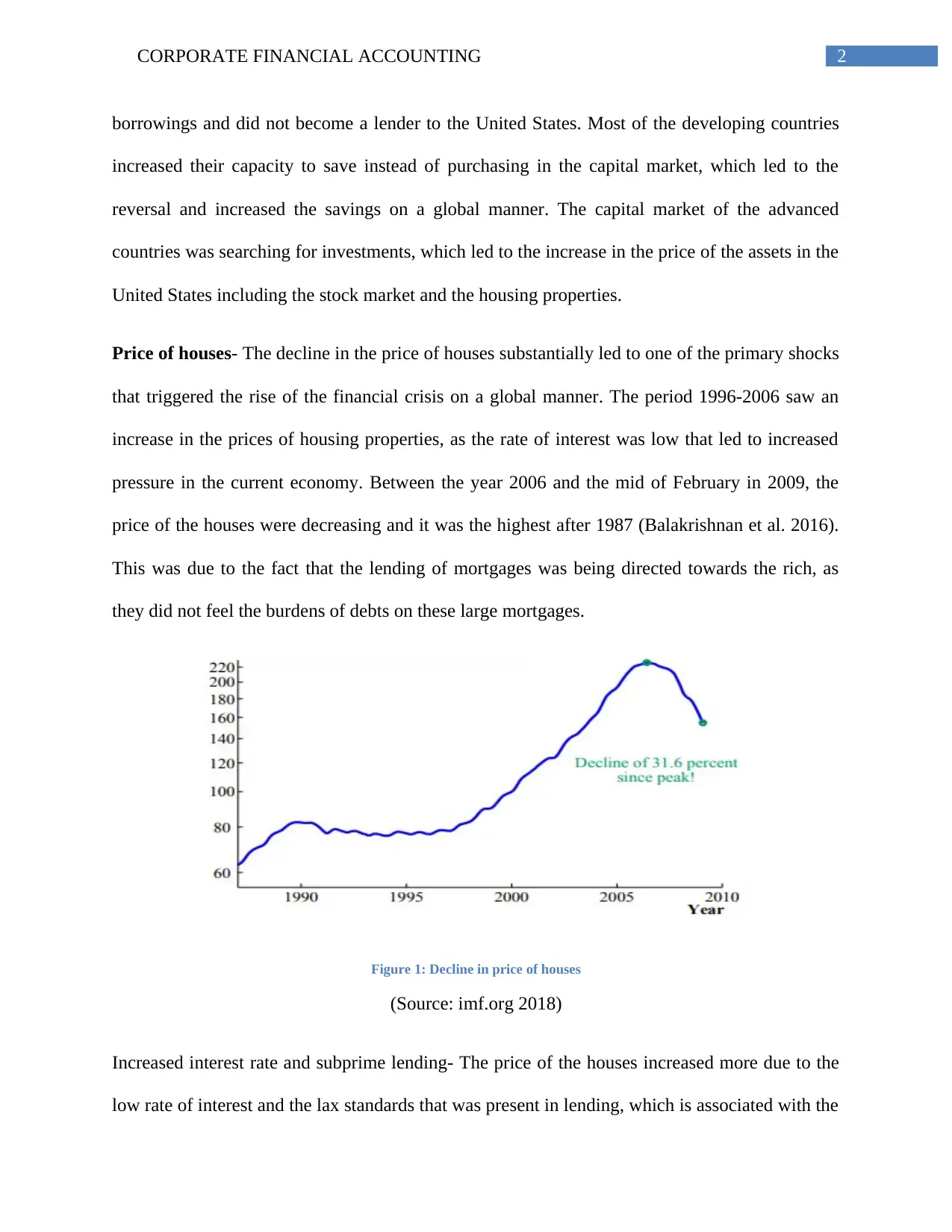
2CORPORATE FINANCIAL ACCOUNTING
borrowings and did not become a lender to the United States. Most of the developing countries
increased their capacity to save instead of purchasing in the capital market, which led to the
reversal and increased the savings on a global manner. The capital market of the advanced
countries was searching for investments, which led to the increase in the price of the assets in the
United States including the stock market and the housing properties.
Price of houses- The decline in the price of houses substantially led to one of the primary shocks
that triggered the rise of the financial crisis on a global manner. The period 1996-2006 saw an
increase in the prices of housing properties, as the rate of interest was low that led to increased
pressure in the current economy. Between the year 2006 and the mid of February in 2009, the
price of the houses were decreasing and it was the highest after 1987 (Balakrishnan et al. 2016).
This was due to the fact that the lending of mortgages was being directed towards the rich, as
they did not feel the burdens of debts on these large mortgages.
Figure 1: Decline in price of houses
(Source: imf.org 2018)
Increased interest rate and subprime lending- The price of the houses increased more due to the
low rate of interest and the lax standards that was present in lending, which is associated with the
borrowings and did not become a lender to the United States. Most of the developing countries
increased their capacity to save instead of purchasing in the capital market, which led to the
reversal and increased the savings on a global manner. The capital market of the advanced
countries was searching for investments, which led to the increase in the price of the assets in the
United States including the stock market and the housing properties.
Price of houses- The decline in the price of houses substantially led to one of the primary shocks
that triggered the rise of the financial crisis on a global manner. The period 1996-2006 saw an
increase in the prices of housing properties, as the rate of interest was low that led to increased
pressure in the current economy. Between the year 2006 and the mid of February in 2009, the
price of the houses were decreasing and it was the highest after 1987 (Balakrishnan et al. 2016).
This was due to the fact that the lending of mortgages was being directed towards the rich, as
they did not feel the burdens of debts on these large mortgages.
Figure 1: Decline in price of houses
(Source: imf.org 2018)
Increased interest rate and subprime lending- The price of the houses increased more due to the
low rate of interest and the lax standards that was present in lending, which is associated with the
⊘ This is a preview!⊘
Do you want full access?
Subscribe today to unlock all pages.

Trusted by 1+ million students worldwide
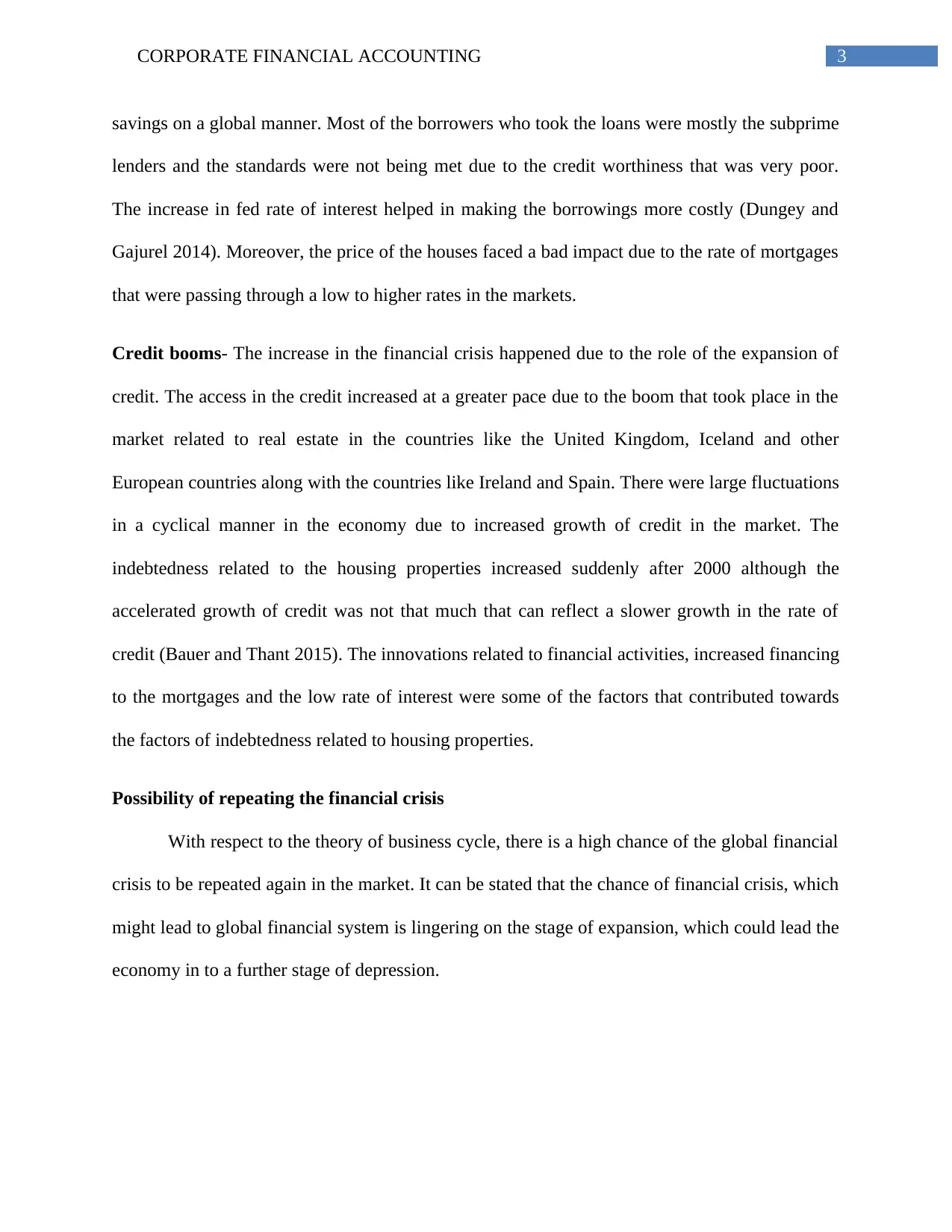
3CORPORATE FINANCIAL ACCOUNTING
savings on a global manner. Most of the borrowers who took the loans were mostly the subprime
lenders and the standards were not being met due to the credit worthiness that was very poor.
The increase in fed rate of interest helped in making the borrowings more costly (Dungey and
Gajurel 2014). Moreover, the price of the houses faced a bad impact due to the rate of mortgages
that were passing through a low to higher rates in the markets.
Credit booms- The increase in the financial crisis happened due to the role of the expansion of
credit. The access in the credit increased at a greater pace due to the boom that took place in the
market related to real estate in the countries like the United Kingdom, Iceland and other
European countries along with the countries like Ireland and Spain. There were large fluctuations
in a cyclical manner in the economy due to increased growth of credit in the market. The
indebtedness related to the housing properties increased suddenly after 2000 although the
accelerated growth of credit was not that much that can reflect a slower growth in the rate of
credit (Bauer and Thant 2015). The innovations related to financial activities, increased financing
to the mortgages and the low rate of interest were some of the factors that contributed towards
the factors of indebtedness related to housing properties.
Possibility of repeating the financial crisis
With respect to the theory of business cycle, there is a high chance of the global financial
crisis to be repeated again in the market. It can be stated that the chance of financial crisis, which
might lead to global financial system is lingering on the stage of expansion, which could lead the
economy in to a further stage of depression.
savings on a global manner. Most of the borrowers who took the loans were mostly the subprime
lenders and the standards were not being met due to the credit worthiness that was very poor.
The increase in fed rate of interest helped in making the borrowings more costly (Dungey and
Gajurel 2014). Moreover, the price of the houses faced a bad impact due to the rate of mortgages
that were passing through a low to higher rates in the markets.
Credit booms- The increase in the financial crisis happened due to the role of the expansion of
credit. The access in the credit increased at a greater pace due to the boom that took place in the
market related to real estate in the countries like the United Kingdom, Iceland and other
European countries along with the countries like Ireland and Spain. There were large fluctuations
in a cyclical manner in the economy due to increased growth of credit in the market. The
indebtedness related to the housing properties increased suddenly after 2000 although the
accelerated growth of credit was not that much that can reflect a slower growth in the rate of
credit (Bauer and Thant 2015). The innovations related to financial activities, increased financing
to the mortgages and the low rate of interest were some of the factors that contributed towards
the factors of indebtedness related to housing properties.
Possibility of repeating the financial crisis
With respect to the theory of business cycle, there is a high chance of the global financial
crisis to be repeated again in the market. It can be stated that the chance of financial crisis, which
might lead to global financial system is lingering on the stage of expansion, which could lead the
economy in to a further stage of depression.
Paraphrase This Document
Need a fresh take? Get an instant paraphrase of this document with our AI Paraphraser
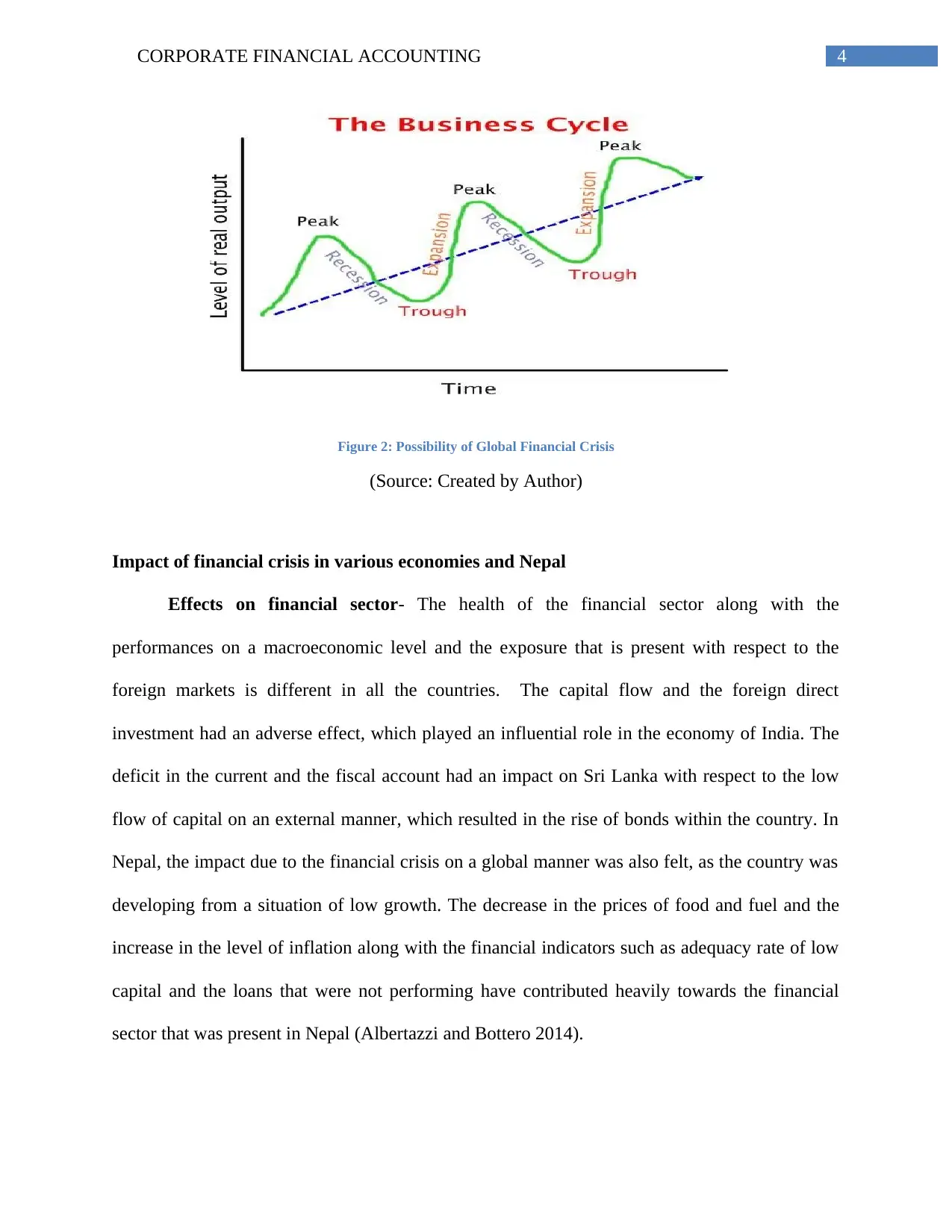
4CORPORATE FINANCIAL ACCOUNTING
Figure 2: Possibility of Global Financial Crisis
(Source: Created by Author)
Impact of financial crisis in various economies and Nepal
Effects on financial sector- The health of the financial sector along with the
performances on a macroeconomic level and the exposure that is present with respect to the
foreign markets is different in all the countries. The capital flow and the foreign direct
investment had an adverse effect, which played an influential role in the economy of India. The
deficit in the current and the fiscal account had an impact on Sri Lanka with respect to the low
flow of capital on an external manner, which resulted in the rise of bonds within the country. In
Nepal, the impact due to the financial crisis on a global manner was also felt, as the country was
developing from a situation of low growth. The decrease in the prices of food and fuel and the
increase in the level of inflation along with the financial indicators such as adequacy rate of low
capital and the loans that were not performing have contributed heavily towards the financial
sector that was present in Nepal (Albertazzi and Bottero 2014).
Figure 2: Possibility of Global Financial Crisis
(Source: Created by Author)
Impact of financial crisis in various economies and Nepal
Effects on financial sector- The health of the financial sector along with the
performances on a macroeconomic level and the exposure that is present with respect to the
foreign markets is different in all the countries. The capital flow and the foreign direct
investment had an adverse effect, which played an influential role in the economy of India. The
deficit in the current and the fiscal account had an impact on Sri Lanka with respect to the low
flow of capital on an external manner, which resulted in the rise of bonds within the country. In
Nepal, the impact due to the financial crisis on a global manner was also felt, as the country was
developing from a situation of low growth. The decrease in the prices of food and fuel and the
increase in the level of inflation along with the financial indicators such as adequacy rate of low
capital and the loans that were not performing have contributed heavily towards the financial
sector that was present in Nepal (Albertazzi and Bottero 2014).
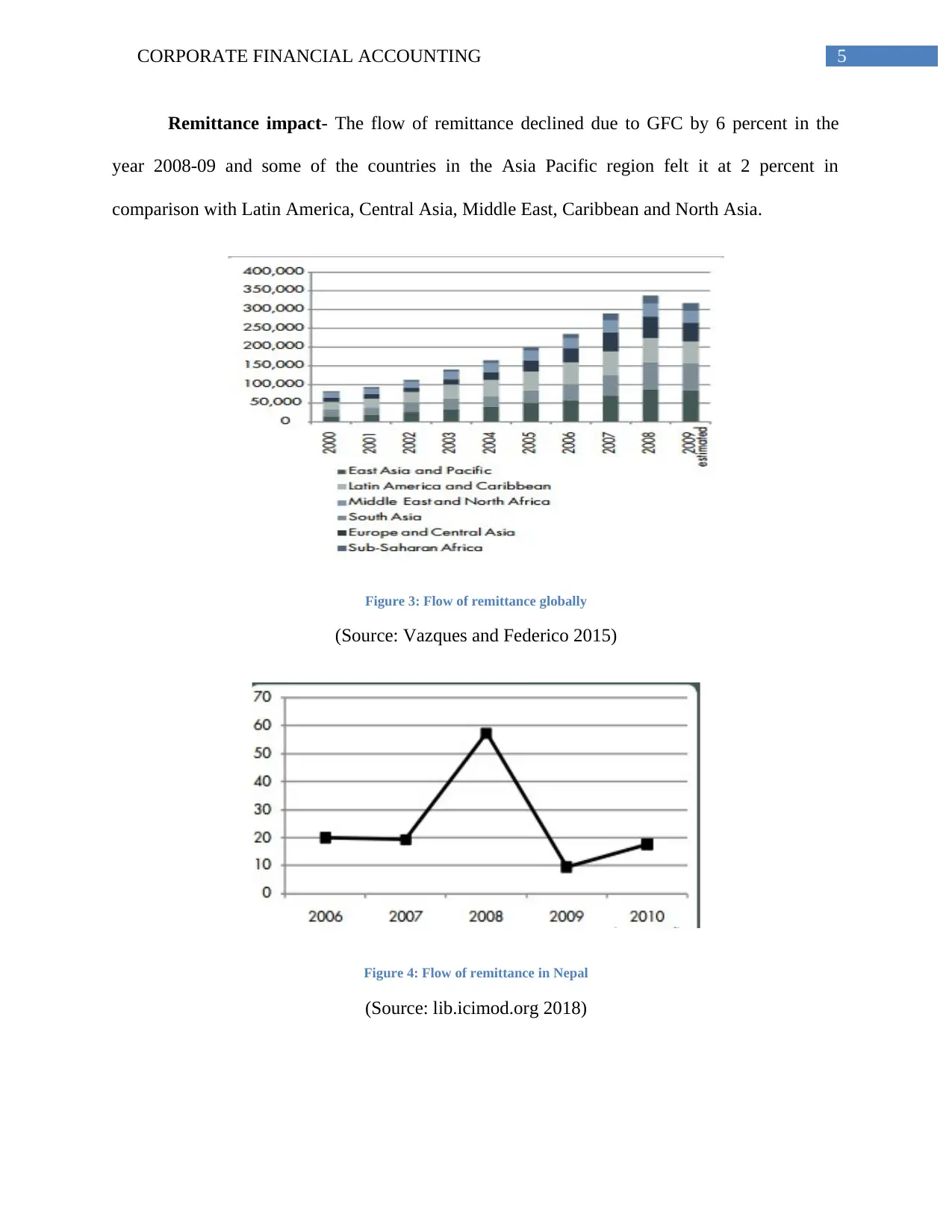
5CORPORATE FINANCIAL ACCOUNTING
Remittance impact- The flow of remittance declined due to GFC by 6 percent in the
year 2008-09 and some of the countries in the Asia Pacific region felt it at 2 percent in
comparison with Latin America, Central Asia, Middle East, Caribbean and North Asia.
Figure 3: Flow of remittance globally
(Source: Vazques and Federico 2015)
Figure 4: Flow of remittance in Nepal
(Source: lib.icimod.org 2018)
Remittance impact- The flow of remittance declined due to GFC by 6 percent in the
year 2008-09 and some of the countries in the Asia Pacific region felt it at 2 percent in
comparison with Latin America, Central Asia, Middle East, Caribbean and North Asia.
Figure 3: Flow of remittance globally
(Source: Vazques and Federico 2015)
Figure 4: Flow of remittance in Nepal
(Source: lib.icimod.org 2018)
⊘ This is a preview!⊘
Do you want full access?
Subscribe today to unlock all pages.

Trusted by 1+ million students worldwide
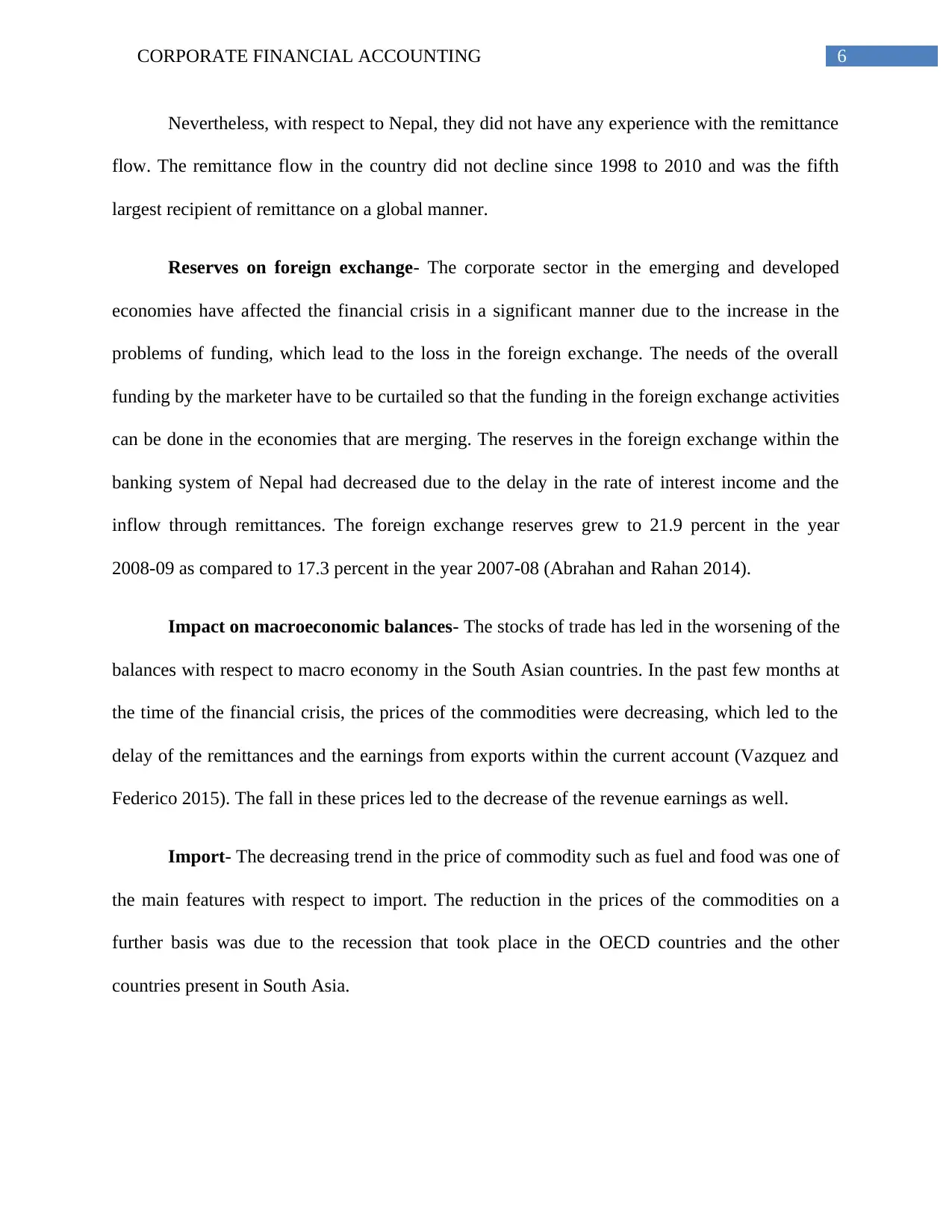
6CORPORATE FINANCIAL ACCOUNTING
Nevertheless, with respect to Nepal, they did not have any experience with the remittance
flow. The remittance flow in the country did not decline since 1998 to 2010 and was the fifth
largest recipient of remittance on a global manner.
Reserves on foreign exchange- The corporate sector in the emerging and developed
economies have affected the financial crisis in a significant manner due to the increase in the
problems of funding, which lead to the loss in the foreign exchange. The needs of the overall
funding by the marketer have to be curtailed so that the funding in the foreign exchange activities
can be done in the economies that are merging. The reserves in the foreign exchange within the
banking system of Nepal had decreased due to the delay in the rate of interest income and the
inflow through remittances. The foreign exchange reserves grew to 21.9 percent in the year
2008-09 as compared to 17.3 percent in the year 2007-08 (Abrahan and Rahan 2014).
Impact on macroeconomic balances- The stocks of trade has led in the worsening of the
balances with respect to macro economy in the South Asian countries. In the past few months at
the time of the financial crisis, the prices of the commodities were decreasing, which led to the
delay of the remittances and the earnings from exports within the current account (Vazquez and
Federico 2015). The fall in these prices led to the decrease of the revenue earnings as well.
Import- The decreasing trend in the price of commodity such as fuel and food was one of
the main features with respect to import. The reduction in the prices of the commodities on a
further basis was due to the recession that took place in the OECD countries and the other
countries present in South Asia.
Nevertheless, with respect to Nepal, they did not have any experience with the remittance
flow. The remittance flow in the country did not decline since 1998 to 2010 and was the fifth
largest recipient of remittance on a global manner.
Reserves on foreign exchange- The corporate sector in the emerging and developed
economies have affected the financial crisis in a significant manner due to the increase in the
problems of funding, which lead to the loss in the foreign exchange. The needs of the overall
funding by the marketer have to be curtailed so that the funding in the foreign exchange activities
can be done in the economies that are merging. The reserves in the foreign exchange within the
banking system of Nepal had decreased due to the delay in the rate of interest income and the
inflow through remittances. The foreign exchange reserves grew to 21.9 percent in the year
2008-09 as compared to 17.3 percent in the year 2007-08 (Abrahan and Rahan 2014).
Impact on macroeconomic balances- The stocks of trade has led in the worsening of the
balances with respect to macro economy in the South Asian countries. In the past few months at
the time of the financial crisis, the prices of the commodities were decreasing, which led to the
delay of the remittances and the earnings from exports within the current account (Vazquez and
Federico 2015). The fall in these prices led to the decrease of the revenue earnings as well.
Import- The decreasing trend in the price of commodity such as fuel and food was one of
the main features with respect to import. The reduction in the prices of the commodities on a
further basis was due to the recession that took place in the OECD countries and the other
countries present in South Asia.
Paraphrase This Document
Need a fresh take? Get an instant paraphrase of this document with our AI Paraphraser
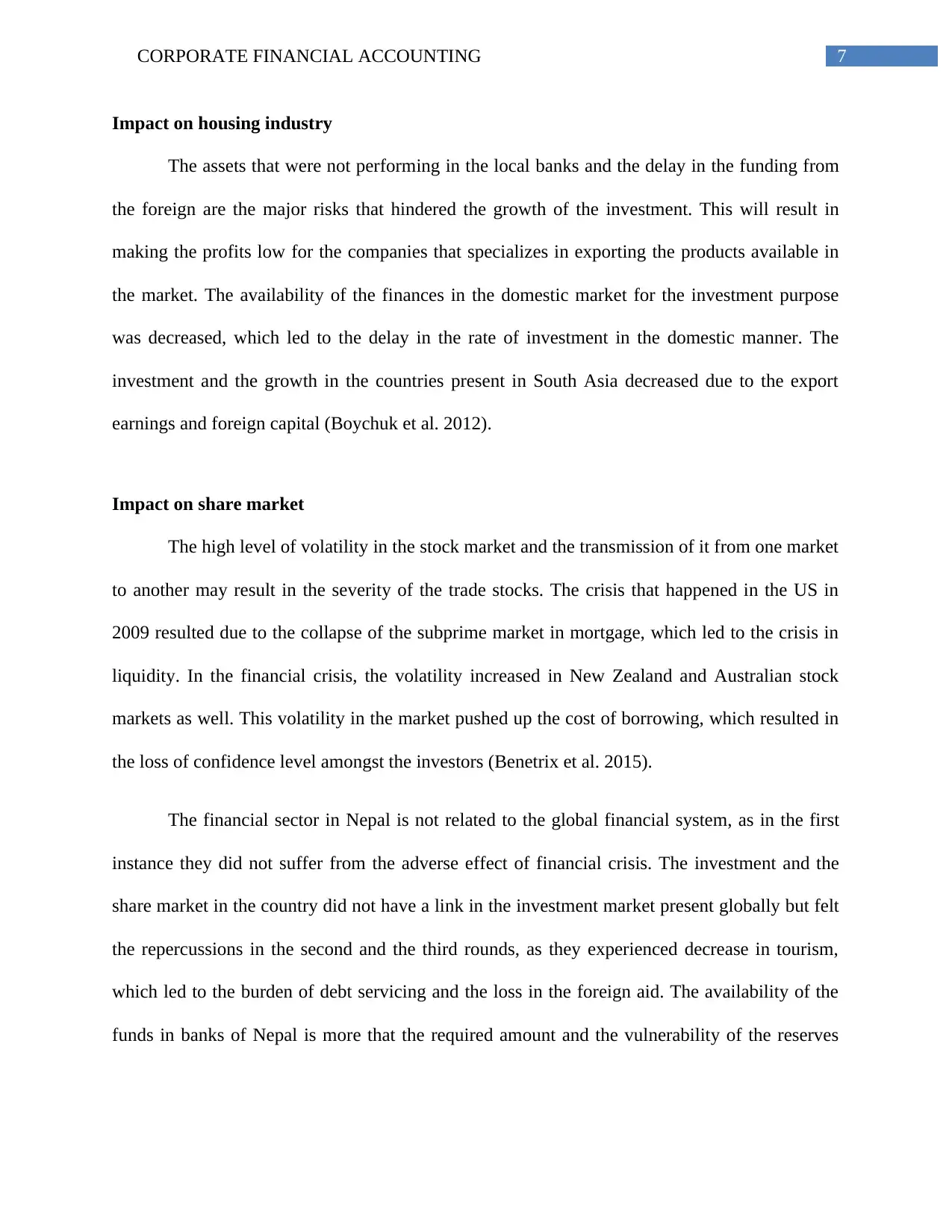
7CORPORATE FINANCIAL ACCOUNTING
Impact on housing industry
The assets that were not performing in the local banks and the delay in the funding from
the foreign are the major risks that hindered the growth of the investment. This will result in
making the profits low for the companies that specializes in exporting the products available in
the market. The availability of the finances in the domestic market for the investment purpose
was decreased, which led to the delay in the rate of investment in the domestic manner. The
investment and the growth in the countries present in South Asia decreased due to the export
earnings and foreign capital (Boychuk et al. 2012).
Impact on share market
The high level of volatility in the stock market and the transmission of it from one market
to another may result in the severity of the trade stocks. The crisis that happened in the US in
2009 resulted due to the collapse of the subprime market in mortgage, which led to the crisis in
liquidity. In the financial crisis, the volatility increased in New Zealand and Australian stock
markets as well. This volatility in the market pushed up the cost of borrowing, which resulted in
the loss of confidence level amongst the investors (Benetrix et al. 2015).
The financial sector in Nepal is not related to the global financial system, as in the first
instance they did not suffer from the adverse effect of financial crisis. The investment and the
share market in the country did not have a link in the investment market present globally but felt
the repercussions in the second and the third rounds, as they experienced decrease in tourism,
which led to the burden of debt servicing and the loss in the foreign aid. The availability of the
funds in banks of Nepal is more that the required amount and the vulnerability of the reserves
Impact on housing industry
The assets that were not performing in the local banks and the delay in the funding from
the foreign are the major risks that hindered the growth of the investment. This will result in
making the profits low for the companies that specializes in exporting the products available in
the market. The availability of the finances in the domestic market for the investment purpose
was decreased, which led to the delay in the rate of investment in the domestic manner. The
investment and the growth in the countries present in South Asia decreased due to the export
earnings and foreign capital (Boychuk et al. 2012).
Impact on share market
The high level of volatility in the stock market and the transmission of it from one market
to another may result in the severity of the trade stocks. The crisis that happened in the US in
2009 resulted due to the collapse of the subprime market in mortgage, which led to the crisis in
liquidity. In the financial crisis, the volatility increased in New Zealand and Australian stock
markets as well. This volatility in the market pushed up the cost of borrowing, which resulted in
the loss of confidence level amongst the investors (Benetrix et al. 2015).
The financial sector in Nepal is not related to the global financial system, as in the first
instance they did not suffer from the adverse effect of financial crisis. The investment and the
share market in the country did not have a link in the investment market present globally but felt
the repercussions in the second and the third rounds, as they experienced decrease in tourism,
which led to the burden of debt servicing and the loss in the foreign aid. The availability of the
funds in banks of Nepal is more that the required amount and the vulnerability of the reserves
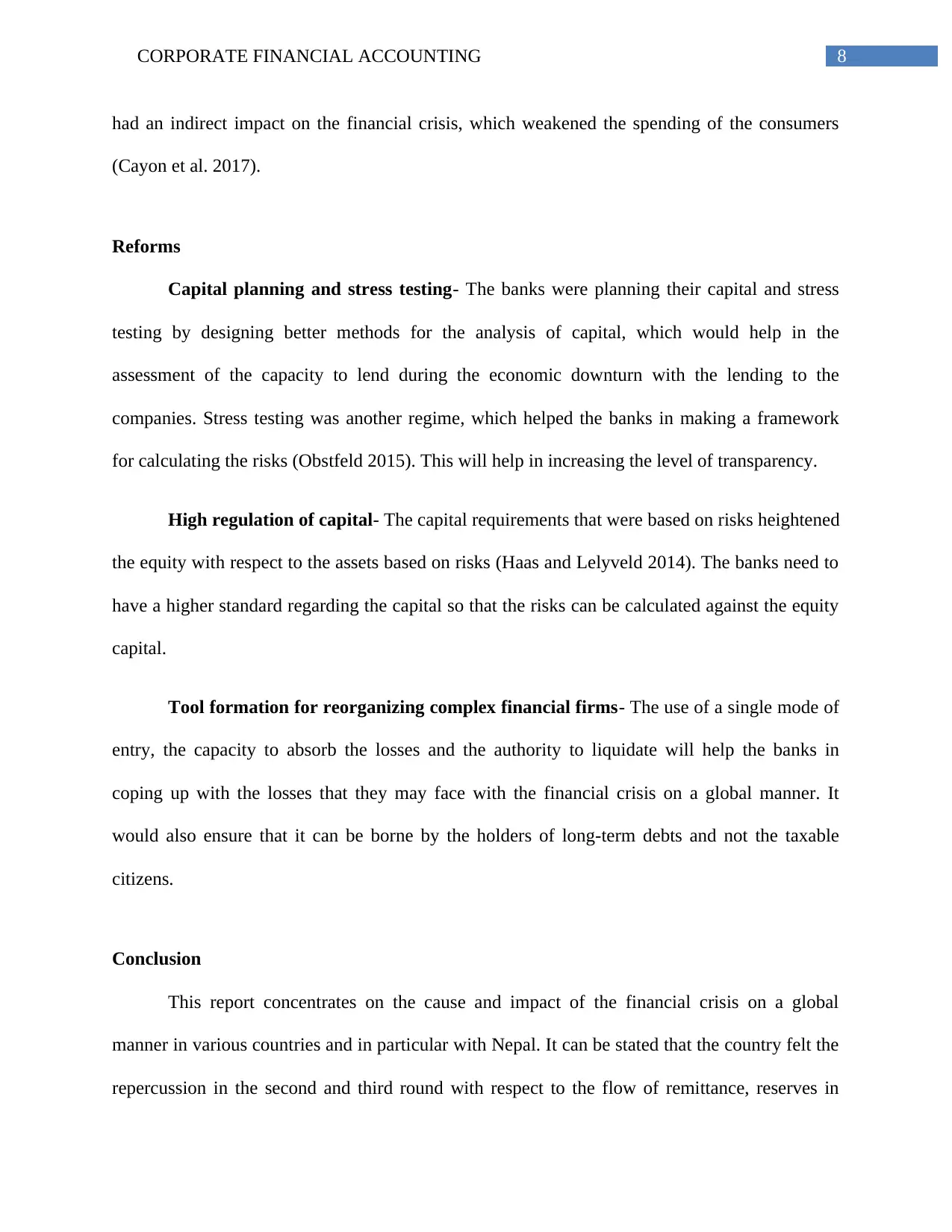
8CORPORATE FINANCIAL ACCOUNTING
had an indirect impact on the financial crisis, which weakened the spending of the consumers
(Cayon et al. 2017).
Reforms
Capital planning and stress testing- The banks were planning their capital and stress
testing by designing better methods for the analysis of capital, which would help in the
assessment of the capacity to lend during the economic downturn with the lending to the
companies. Stress testing was another regime, which helped the banks in making a framework
for calculating the risks (Obstfeld 2015). This will help in increasing the level of transparency.
High regulation of capital- The capital requirements that were based on risks heightened
the equity with respect to the assets based on risks (Haas and Lelyveld 2014). The banks need to
have a higher standard regarding the capital so that the risks can be calculated against the equity
capital.
Tool formation for reorganizing complex financial firms- The use of a single mode of
entry, the capacity to absorb the losses and the authority to liquidate will help the banks in
coping up with the losses that they may face with the financial crisis on a global manner. It
would also ensure that it can be borne by the holders of long-term debts and not the taxable
citizens.
Conclusion
This report concentrates on the cause and impact of the financial crisis on a global
manner in various countries and in particular with Nepal. It can be stated that the country felt the
repercussion in the second and third round with respect to the flow of remittance, reserves in
had an indirect impact on the financial crisis, which weakened the spending of the consumers
(Cayon et al. 2017).
Reforms
Capital planning and stress testing- The banks were planning their capital and stress
testing by designing better methods for the analysis of capital, which would help in the
assessment of the capacity to lend during the economic downturn with the lending to the
companies. Stress testing was another regime, which helped the banks in making a framework
for calculating the risks (Obstfeld 2015). This will help in increasing the level of transparency.
High regulation of capital- The capital requirements that were based on risks heightened
the equity with respect to the assets based on risks (Haas and Lelyveld 2014). The banks need to
have a higher standard regarding the capital so that the risks can be calculated against the equity
capital.
Tool formation for reorganizing complex financial firms- The use of a single mode of
entry, the capacity to absorb the losses and the authority to liquidate will help the banks in
coping up with the losses that they may face with the financial crisis on a global manner. It
would also ensure that it can be borne by the holders of long-term debts and not the taxable
citizens.
Conclusion
This report concentrates on the cause and impact of the financial crisis on a global
manner in various countries and in particular with Nepal. It can be stated that the country felt the
repercussion in the second and third round with respect to the flow of remittance, reserves in
⊘ This is a preview!⊘
Do you want full access?
Subscribe today to unlock all pages.

Trusted by 1+ million students worldwide
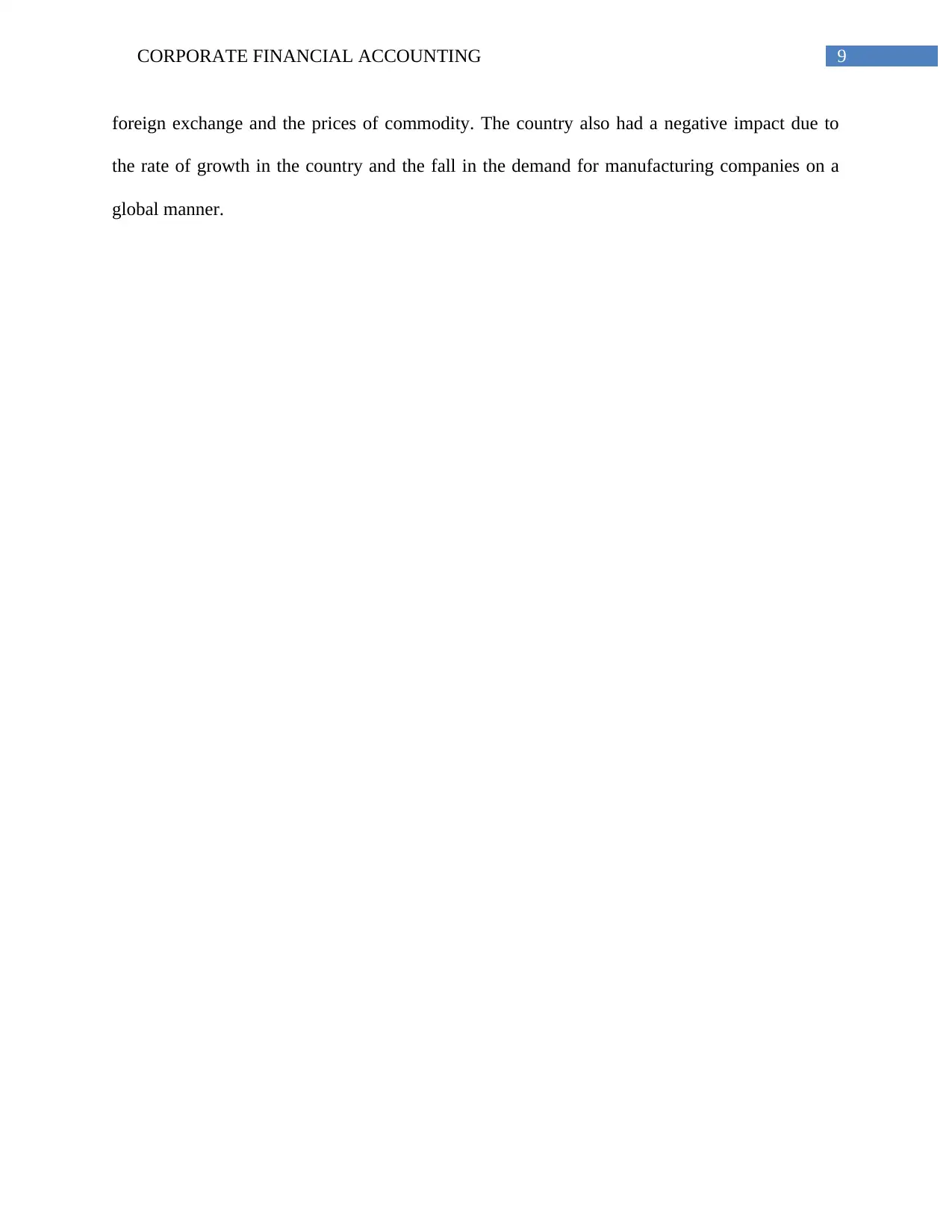
9CORPORATE FINANCIAL ACCOUNTING
foreign exchange and the prices of commodity. The country also had a negative impact due to
the rate of growth in the country and the fall in the demand for manufacturing companies on a
global manner.
foreign exchange and the prices of commodity. The country also had a negative impact due to
the rate of growth in the country and the fall in the demand for manufacturing companies on a
global manner.
Paraphrase This Document
Need a fresh take? Get an instant paraphrase of this document with our AI Paraphraser
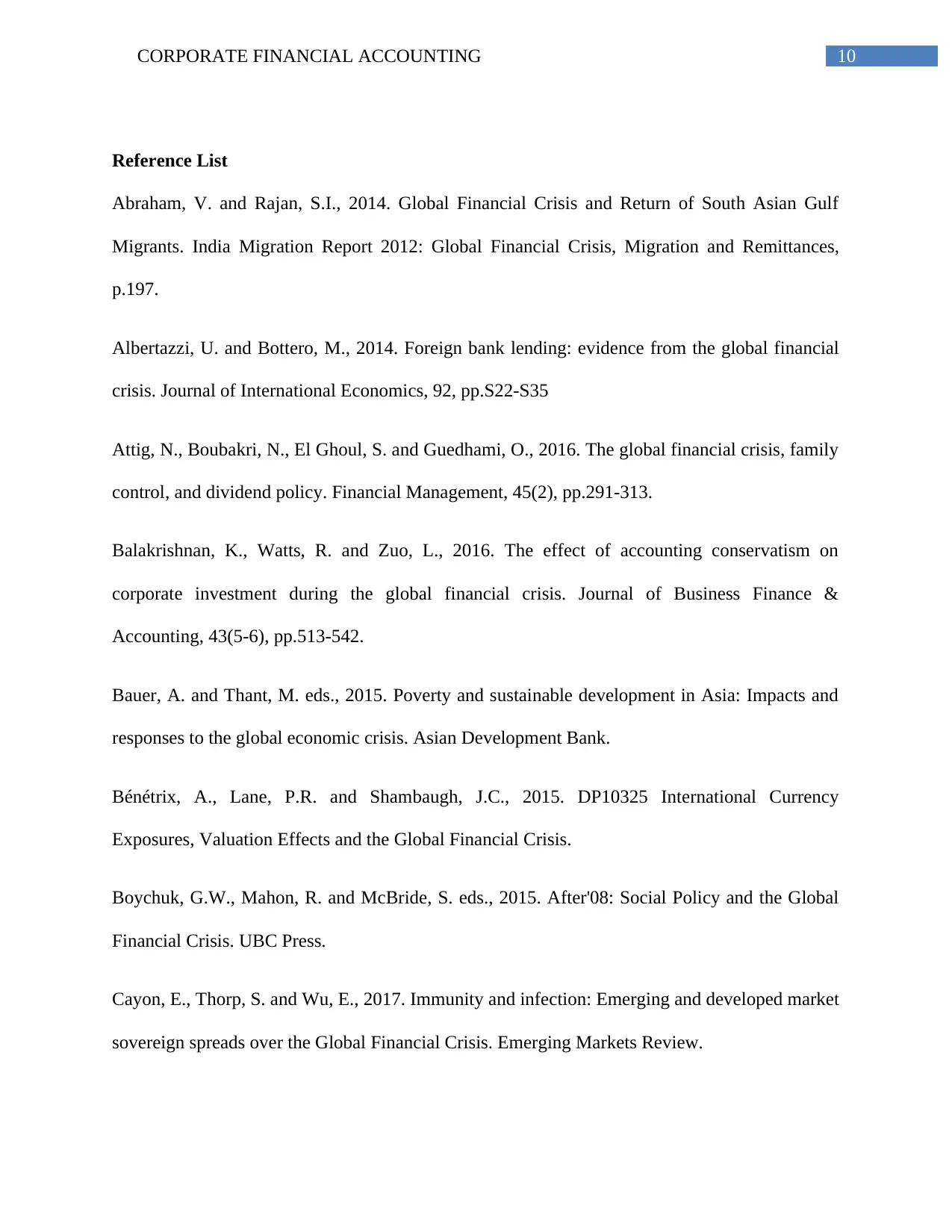
10CORPORATE FINANCIAL ACCOUNTING
Reference List
Abraham, V. and Rajan, S.I., 2014. Global Financial Crisis and Return of South Asian Gulf
Migrants. India Migration Report 2012: Global Financial Crisis, Migration and Remittances,
p.197.
Albertazzi, U. and Bottero, M., 2014. Foreign bank lending: evidence from the global financial
crisis. Journal of International Economics, 92, pp.S22-S35
Attig, N., Boubakri, N., El Ghoul, S. and Guedhami, O., 2016. The global financial crisis, family
control, and dividend policy. Financial Management, 45(2), pp.291-313.
Balakrishnan, K., Watts, R. and Zuo, L., 2016. The effect of accounting conservatism on
corporate investment during the global financial crisis. Journal of Business Finance &
Accounting, 43(5-6), pp.513-542.
Bauer, A. and Thant, M. eds., 2015. Poverty and sustainable development in Asia: Impacts and
responses to the global economic crisis. Asian Development Bank.
Bénétrix, A., Lane, P.R. and Shambaugh, J.C., 2015. DP10325 International Currency
Exposures, Valuation Effects and the Global Financial Crisis.
Boychuk, G.W., Mahon, R. and McBride, S. eds., 2015. After'08: Social Policy and the Global
Financial Crisis. UBC Press.
Cayon, E., Thorp, S. and Wu, E., 2017. Immunity and infection: Emerging and developed market
sovereign spreads over the Global Financial Crisis. Emerging Markets Review.
Reference List
Abraham, V. and Rajan, S.I., 2014. Global Financial Crisis and Return of South Asian Gulf
Migrants. India Migration Report 2012: Global Financial Crisis, Migration and Remittances,
p.197.
Albertazzi, U. and Bottero, M., 2014. Foreign bank lending: evidence from the global financial
crisis. Journal of International Economics, 92, pp.S22-S35
Attig, N., Boubakri, N., El Ghoul, S. and Guedhami, O., 2016. The global financial crisis, family
control, and dividend policy. Financial Management, 45(2), pp.291-313.
Balakrishnan, K., Watts, R. and Zuo, L., 2016. The effect of accounting conservatism on
corporate investment during the global financial crisis. Journal of Business Finance &
Accounting, 43(5-6), pp.513-542.
Bauer, A. and Thant, M. eds., 2015. Poverty and sustainable development in Asia: Impacts and
responses to the global economic crisis. Asian Development Bank.
Bénétrix, A., Lane, P.R. and Shambaugh, J.C., 2015. DP10325 International Currency
Exposures, Valuation Effects and the Global Financial Crisis.
Boychuk, G.W., Mahon, R. and McBride, S. eds., 2015. After'08: Social Policy and the Global
Financial Crisis. UBC Press.
Cayon, E., Thorp, S. and Wu, E., 2017. Immunity and infection: Emerging and developed market
sovereign spreads over the Global Financial Crisis. Emerging Markets Review.
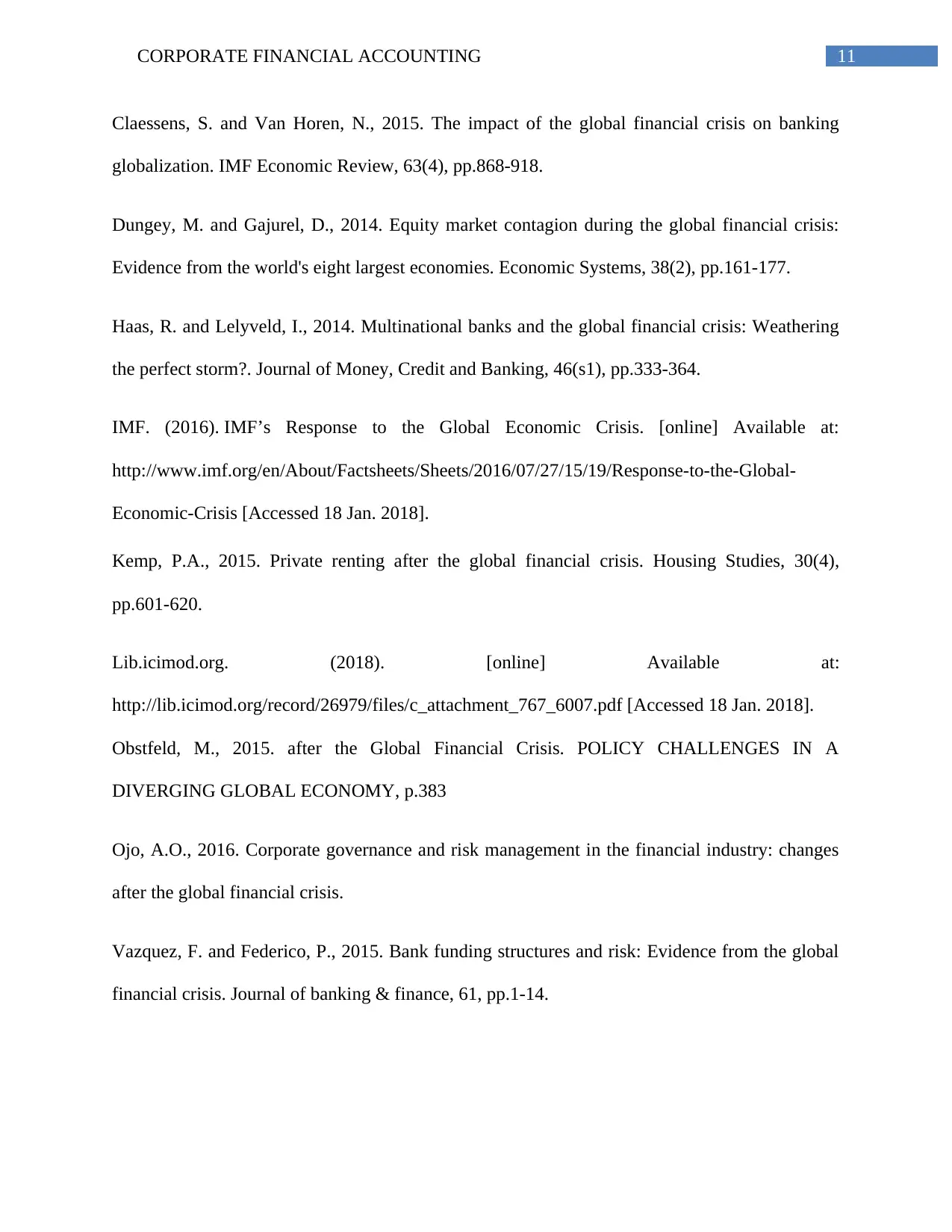
11CORPORATE FINANCIAL ACCOUNTING
Claessens, S. and Van Horen, N., 2015. The impact of the global financial crisis on banking
globalization. IMF Economic Review, 63(4), pp.868-918.
Dungey, M. and Gajurel, D., 2014. Equity market contagion during the global financial crisis:
Evidence from the world's eight largest economies. Economic Systems, 38(2), pp.161-177.
Haas, R. and Lelyveld, I., 2014. Multinational banks and the global financial crisis: Weathering
the perfect storm?. Journal of Money, Credit and Banking, 46(s1), pp.333-364.
IMF. (2016). IMF’s Response to the Global Economic Crisis. [online] Available at:
http://www.imf.org/en/About/Factsheets/Sheets/2016/07/27/15/19/Response-to-the-Global-
Economic-Crisis [Accessed 18 Jan. 2018].
Kemp, P.A., 2015. Private renting after the global financial crisis. Housing Studies, 30(4),
pp.601-620.
Lib.icimod.org. (2018). [online] Available at:
http://lib.icimod.org/record/26979/files/c_attachment_767_6007.pdf [Accessed 18 Jan. 2018].
Obstfeld, M., 2015. after the Global Financial Crisis. POLICY CHALLENGES IN A
DIVERGING GLOBAL ECONOMY, p.383
Ojo, A.O., 2016. Corporate governance and risk management in the financial industry: changes
after the global financial crisis.
Vazquez, F. and Federico, P., 2015. Bank funding structures and risk: Evidence from the global
financial crisis. Journal of banking & finance, 61, pp.1-14.
Claessens, S. and Van Horen, N., 2015. The impact of the global financial crisis on banking
globalization. IMF Economic Review, 63(4), pp.868-918.
Dungey, M. and Gajurel, D., 2014. Equity market contagion during the global financial crisis:
Evidence from the world's eight largest economies. Economic Systems, 38(2), pp.161-177.
Haas, R. and Lelyveld, I., 2014. Multinational banks and the global financial crisis: Weathering
the perfect storm?. Journal of Money, Credit and Banking, 46(s1), pp.333-364.
IMF. (2016). IMF’s Response to the Global Economic Crisis. [online] Available at:
http://www.imf.org/en/About/Factsheets/Sheets/2016/07/27/15/19/Response-to-the-Global-
Economic-Crisis [Accessed 18 Jan. 2018].
Kemp, P.A., 2015. Private renting after the global financial crisis. Housing Studies, 30(4),
pp.601-620.
Lib.icimod.org. (2018). [online] Available at:
http://lib.icimod.org/record/26979/files/c_attachment_767_6007.pdf [Accessed 18 Jan. 2018].
Obstfeld, M., 2015. after the Global Financial Crisis. POLICY CHALLENGES IN A
DIVERGING GLOBAL ECONOMY, p.383
Ojo, A.O., 2016. Corporate governance and risk management in the financial industry: changes
after the global financial crisis.
Vazquez, F. and Federico, P., 2015. Bank funding structures and risk: Evidence from the global
financial crisis. Journal of banking & finance, 61, pp.1-14.
⊘ This is a preview!⊘
Do you want full access?
Subscribe today to unlock all pages.

Trusted by 1+ million students worldwide
1 out of 13
Related Documents
Your All-in-One AI-Powered Toolkit for Academic Success.
+13062052269
info@desklib.com
Available 24*7 on WhatsApp / Email
![[object Object]](/_next/static/media/star-bottom.7253800d.svg)
Unlock your academic potential
Copyright © 2020–2025 A2Z Services. All Rights Reserved. Developed and managed by ZUCOL.





